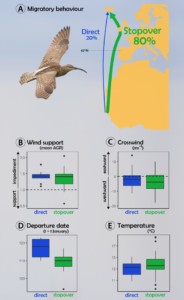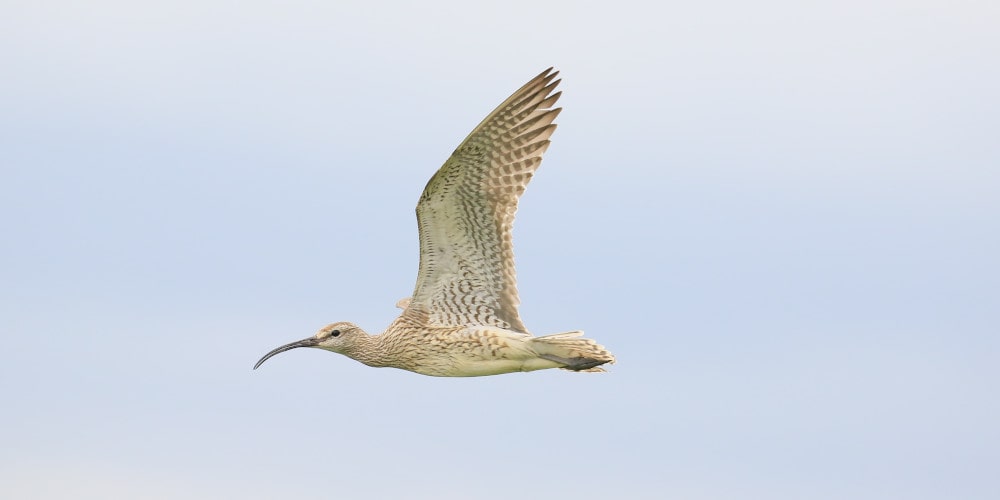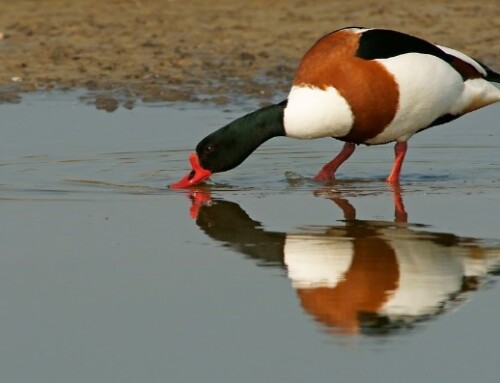LINKED PAPER
Linking weather and phenology to stopover dynamics of a long-distance migrant. Carneiro, C, Gunnarsson, T.G. & Alves, J.A. 2020. Frontiers in Ecology and Evolution. DOI: 10.3389/fevo.2020.00145. VIEW
There is a wide range of behaviours performed by migratory birds when moving between the breeding and non-breeding areas (Newton 2007). Some undertake long non-stop flights, while others may cover the distance in smaller flights intercalated by several stopovers (Piersma 1987). In the case of Icelandic Whimbrel (Numenius phaeopus islandicus), two main migratory behaviours have been observed during spring, when these waders move from the wintering sites (mostly in West Africa) to the breeding grounds in Iceland. In around 80% of the cases, Whimbrels make a flight to a stopover area (frequently in Britain and Ireland) – ‘stopover behaviour’ – while in the remaining 20% of cases the migratory flight is non-stop – ‘direct behaviour’ (Figure 1A; Carneiro et al. 2019a). What are the reasons behind these two behaviours? Do Whimbrels determine a strategy at/before departure, or adjust their behaviour during migration?
Weather plays an important role in long-distance migrations. Wind conditions are known to support or hinder bird migration, both during flight and stationary periods (Shamoun-Baranes et al. 2017), and temperature has been shown to influence departure decisions (Berchtold et al. 2017). Additionally, schedule may also influence migratory behaviour. For example, the departure date from the wintering sites can influence the subsequent stopover duration (Lindström et al. 2016).

Figure 1 A: Schematic representations of the Icelandic Whimbrel spring migratory behaviours, with “decision latitude” depicted at 42°N. B: Mean individual air-to-ground speed ratio (AGR) from departure up to latitude 42°N. C: Zonal wind (u) component, between 37 and 50°N. D: Departure date from the wintering site. E: Air temperature experienced by each individual at latitude 42°N. n = 9 direct and 48 stopover migrations in B, D and E; n = 18 direct and 80 stopover migrations in C (larger sample here because between those latitudes the number of locations per track can be more than one). All data refers to air pressure 1000 hPa (i.e. 111 m a. s. l.). Boxplots show the median and 25 and 75% quartiles, whiskers extending up to 1.5 times the inter quartile range from the median and points beyond that are individually marked in black. Photo © Tómas G. Gunnarsson
After 6 years of intensive individual tracking, we compiled 9 direct and 48 stopover spring migrations, performed by 36 Icelandic Whimbrels that carried a geolocator. These data were annotated with wind and temperature information, and the departure date from the wintering sites was determined. Then, we defined 42°N as a “decision latitude” where birds might change overall direction of migration (Figure 1A), and tested if (1) wind support experienced until this latitude (quantified as the mean Air-to-Ground speed Ratio) and (2) the temperature at this latitude differed for individuals performing each behaviour. Then (3) compared crosswinds experienced when individuals approach the main stopover region (37 – 50°N); and finally (4) tested the effect of departure date from the wintering sites.
We found no differences in wind support during migratory flights (Figure 1B), in temperature closer to Iceland (Figure 1E) nor on crosswinds experienced in the region before reaching the main stopover areas (Figure 1C). However, individuals that performed a stopover behaviour tended to depart earlier than those that would fly direct (Figure 1D).
The same Whimbrel can perform direct and stopover behaviours in different years (Carneiro et al. 2019b). Hence, for three birds that changed migratory behaviour (in all cases from direct to stopover), we also compared the same variables at the individual level. In all cases, individuals reflected the pattern observed at the population level, despite the consistency in spring departure date observed in this population (Carneiro et al. 2019b).
Whimbrels tend to arrive earlier to the breeding sites after a direct migratory flight, which may allow to compensate for a potential delay at departure. However, the timing of laying does not seem to differ between migratory behaviours. As the timing of breeding can influence breeding success (Morrison et al. 2019), and this is true in the case for Icelandic Whimbrels, a direct migration may not translate into an advantage in terms of breeding success.
If conditions during flight are not different between behaviours and there are no clear advantages for an early arrival after a direct migration, then why performing a stopover is predominant across the population? The main stopover sites are in Britain and Ireland, which are relatively close to the breeding sites in Iceland. Hence, Whimbrels might be able to assess the weather conditions at the breeding locations during stopover, adjust arrival date into Iceland to when those are favourable, and therefore avoid the risk of inclement weather prior to breeding.
References
Berchtold, A., Nightingale, I., Vandermeer, C. & MacDougall-Shackleton, S.A. 2017. Experimental temperature manipulations alter songbird autumnal nocturnal migratory restlessness. Anim. Migr. 4: 1–7. VIEW
Carneiro, C., Gunnarsson, T.G. & Alves, J.A. 2019a. Faster migration in autumn than in spring: seasonal migration patterns and non-breeding distribution of Icelandic whimbrels Numenius phaeopus islandicus. J Avian Biol. 50: 1-8. VIEW
Carneiro, C., Gunnarsson, T.G. & Alves, J.A. 2019b. Why are Whimbrels Not Advancing Their Arrival Dates Into Iceland? Exploring Seasonal and Sex-Specific Variation in Consistency of Individual Timing During the Annual Cycle. Front. Ecol. Evol. 7: 1-8. VIEW
Lindström, Å., Alerstam, T., Bahlenberg, P., Ekblom, R., Fox, J.W., Råghall, J. & Klaassen, R.H.G. 2016. The migration of the great snipe Gallinago media: intriguing variations on a grand theme. J. Avian Biol. 47: 321-334. VIEW
Morrison, C.A., Alves, J.A., Gunnarsson, T.G., Thorisson, B. & Gill, J.A. 2019. Why do earlier-arriving migratory birds have better breeding success? Ecol. Evol. 9: 8856-8864. VIEW
Newton, I. 2007. The Migration Ecology of Birds. Academic Press.
Piersma, T. 1987. Hop, skip or jump? Constraints on migration of artic waders by feeding, fattening and flight speed. Limosa 60: 185-194. VIEW
Piersma, T. 1987. Hop, skip or jump? Constraints on migration of arctic waders by feeding, fattening and flight speed. Limosa 60: 185–194. VIEW
Shamoun-Baranes, J., Liechti, F. & Vansteelant, W.M.G. 2017. Atmospheric conditions create freeways, detours and tailbacks for migrating birds. J. Comp. Physiol. A Neuroethol. Sensory, Neural, Behav. Physiol. 203: 509–529. VIEW
Image credit
Featured image: Icelandic Whimbrel Numenius phaeopus islandicus in the breeding grounds © Tómas G. Gunnarsson




